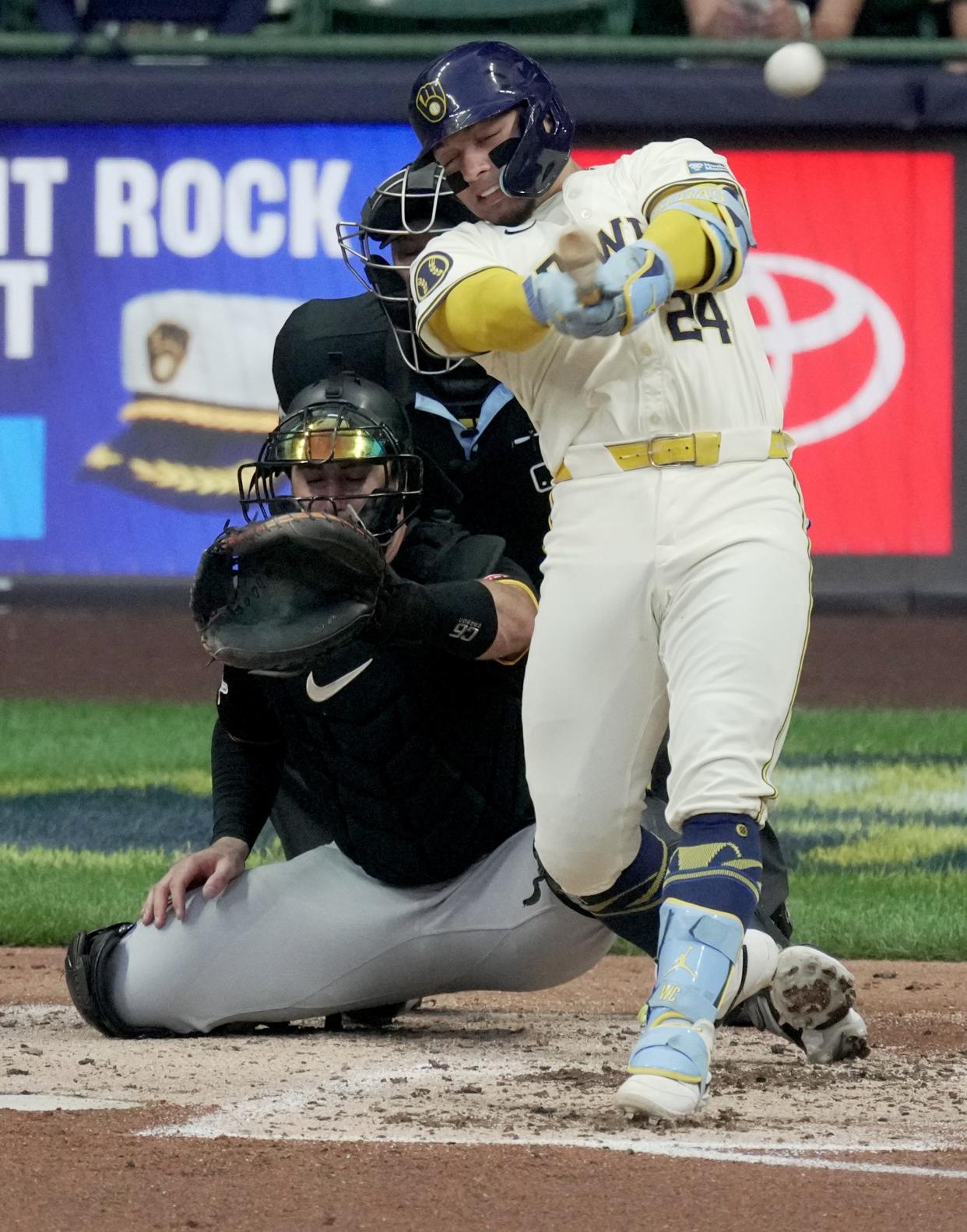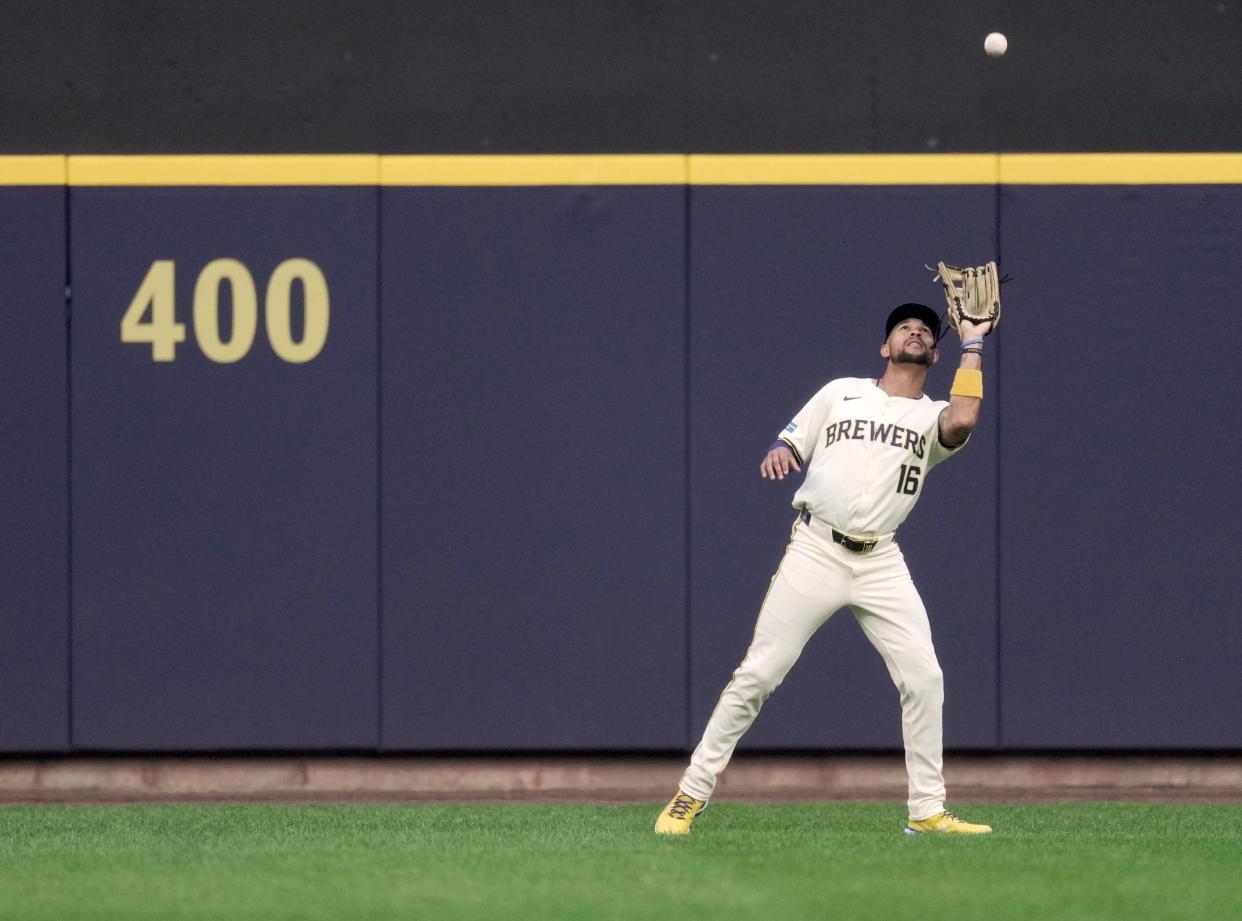Lori Nickel: Here are the best baseball stats to follow from smart people who know
"I know, we're nerds. And some people are like, 'Shut up, nerd, .300 is good!' I get that; I'm not debating that. But there are other ways that we can analyze players − and make them better and try to find ways to improve the team."
DomCotroneo took the SAT in seventh grade because he was a smart kid on the gifted-and-talented track. He wanted to be an astronaut. Or a teacher. But he went to a state university and dropped out. And now he's working in ... baseball. And not just baseball, but in one of the lowest-paid, highest-stressed fields in the United States.
"I know. Broadcasting. Media. Journalism," Cotroneo said during a chat on the benches outside of the Brewers clubhouse at American Family Field. The slight tone of derision hangs in the air like Wisconsin humidity.
But Cotroneo is The Man. He interprets and computes the internal baseball statistics for Bally Sports Network. He also works for the pregame and postgame Brewers shows on WTMJ. He's the internal stats expert for sportscaster Brian Anderson for national baseball games on TBS. And he's the famous Dom that we hear about in Brewers television broadcasts (see Story 1).

He is not the enemy − and the numbers are not, either.
"The game is run by nerds," another Milwaukee baseball media member says matter-of-factly as we lean over the dugout railing and watch batting practice. The crack of the bat is mesmerizing. For all the data and information overload we deal with every day, this sound is pure and true and conjures up memories of playing in the backyard or digging cleats into the batter's box in high school. Just because there's now a stat for that sound (and William Contreras owns it) doesn't detract from this moment. An open roof, a cloudless day and − despite all the predictability from the statistics − a venture into the unknown.
You don't need stats to love baseball.
But Cotroneo, Brewers broadcaster Jeff Levering, along with Brewers manager Pat Murphy and a few Brewers, shed some light on the metrics, statistics and analytics that are so often referred to in news conferences, Brewers game coverage and postgame interviews. Here are a few stats we could get to know for a deeper appreciation of this game.
First, the beginner level:
WAR: Wins Against Replacement
This starts at zero for the average MLB player and measures "a player's value in all facets of the game by deciphering how many more wins he's worth than a replacement-level player at his same position."
RPMs: Revolutions Per Minute or SR: Spin rate
The turns the baseball makes with a throw made by the pitcher. The stat is often used with a pitcher's velocity − or how fast the ball is thrown, measured in miles per hour. Murphy considers RPMs in conjunction with other observations in his evaluation of players.
“You can see what you can see,” Murphy said. “The fastball 'with the great RPMs' – the hitter tells you it’s a good fastball. Bryan Hudson, he’s either got great extension or great RPMs because it’s 91 mph up on the board – and nobody is getting to him.”
WHIP: Walks and Hits Per Inning
"It's very important to have a very low WHIP,” Levering said of this pitchers' stat. “If you have a WHIP above 2, that means you're giving up two, or two base runners. If you're under 1, that means you're allowing one or fewer walks or hits per inning. And that's good."
Pop Time
How fast the catcher can throw the ball to second base after the ball touches his mitt. Murphy said this statistic usually confirms what he already senses.
“You just kind of get a feel for pop times from a catcher,” Murphy said. “We can do pop times with the watch, but I could tell you within a 10th of a second. I can tell you the difference between 2.0 and 1.8.
“I can tell you not because my eyes are great; but because every baseball person who does this for a living can do that. It’s a crazy thing − but we do this for a living. God forbid if we had a real job.”
OPS: On-Base Plus Slugging
The sum of a player’s on-base percentage and slugging percentage. It tries to put a number on the ability of a player both to get on base and to hit for power, two important offensive skills.
“We think of OPS as being a stat that kind of tells the whole picture of the player because it's how much he's getting on base and how much slug he's getting,” Cotroneo said.
There's also OPS+, but it's kind of complicated and not everyone in the media even understands it. Stat newbies, stick to OPS.
Spray Chart
This is kind of like Pull%, Cent% and Oppo% − a spray chart tells us where in the field a batter hits the ball, and trends can be gleaned from this data to help the defense position itself.
Brewers outfielder Blake Perkins said he doesn't study any of the public stats on this. However, he relies directly on what the coaches tell him from the Brewers' in-house data.

Levering said it's a useful general tool.
"If you know a (batter’s) spray chart and you see he goes to the opposite field a lot more − his opposite field percentage is 70% − I'm going to put my guys (on defense) more on that side," Levering said. "Because that's where (the batter) is going to hit the ball.
“That's the opposite-field percentage, center-field percentage and pull percentage − how often he hits that particular baseball to that part of the field.”
Now, the intermediate level:
BABIP: Batting Average on Balls In Play
BABIP measures a player's batting average on balls hit into the field of play, removing home runs and strikeouts. It looks like a batting average. For example, a hitter who goes 2-for-5 with a home run and a strikeout would have a .333 BABIP. He's 1-for-3 on the balls he put in play.
"It's beneficial to know whether a guy's lucky," Murphy said. "So his BABIP might be more important in a situation. The guy that punches out a lot and has a low BABIP, you know, wow − maybe got a little unlucky.”
When he's analyzing a player, Levering said, he's not just looking at batting average and slugging percentage. He's looking at BABIP.
“That means he's putting the ball in play more," Levering said. "Say he's hitting .350 on his batting average on balls in play, but overall, he's hitting .275. That means he's striking out a ton because he's not putting the ball in play. But when he does, he's getting a hit three and a half times out of 10."
For an example, look at Brewers shortstop Willy Adames. His batting average is .246. His BABIP is .289.

“It doesn't take into account exit velocity," Levering said. "It doesn't take into whether it was a double, a triple, a home run. How many guys you drove in.
"It is simply: did you put the ball in play? And did you reach base?"
Defensive Runs Saved
This actual stat is a little hard to find on the internet, so look for it the most in media coverage of the Brewers.
Cotroneo wants you to think of Brewers second baseman Brice Turang as the perfect example of this stat.
“Defense is really hard to grade, but we do have new ways to do it,” Cotroneo said. “And one of the sites that has been doing it for a long, long time is called Fielding Bible, and they have been ranking and rating a stat that they created called 'defensive runs saved.'
“Defensive runs saved basically means, how many more plays − above average − are you making in the collective? Does that work for saving runs? Are you a positive defender?
“Brice Turang is actually the best defender in baseball, according to defensive runs saved, and the reason why a 12-year-old or somebody in a nursing home can understand that stat is it's an easy counting stat. Meaning, just keep adding to it."
It's another stat in which zero equals average.
“But the other beauty of it is humans actually helped create (it)," Cotroneo said. "There's actually an eye test, a scouting aspect to it so the humans have to agree with what the computers are telling you. It's a beautiful blend of what baseball actually is. 'Defensive run saved’ is basically saying Brice Turang is one of the best defenders in baseball, which we know with our eye test.”
ERA: Earned Run Average and xERA: Expected Earned Run Average
MLB's definition is a mess: "Expected ERA, or xERA, is a simple 1:1 translation of Expected Weighted On-Base Average (xwOBA), converted to the ERA scale. xwOBA takes into account the amount of contact (strikeouts, walks, hit by pitch) and the quality of that contact (exit velocity and launch angle), in an attempt to credit the pitcher or hitter for the moment of contact, not for what might happen to that contact thanks to other factors like ballpark, weather, or defense."
Levering boils xERA down.
“That takes into account luck, that takes into account ballpark effect,” he said. “So if a guy's real Earned Run Average is 5.5, but his expected Earned Run Average is 4, it should mean that he's pitching better than a 5.5 Earned Run Average. But the statistic of expected Earned Run Average would explain differently − he's got bad luck or he's not getting calls."
Finally, the advanced level:
Hard-Hit Rate or Barrel Percentage
Now you're picking your stat preferences; do you want ketchup and mustard, or the works? Hard-hit rate tracks balls that were were hit at 95 mph or more.
We like Barrel %.
"They did come up with new stats this year about barrel percentage and blast rate − on how hard you were hitting a ball by its exit velocity and the launch angle,” Levering said.
“Barrel percentage − it's that little area on the bat that you hit it perfectly on the barrel of the bat.
"You don't need that stat; you don’t! But it sounds cool. And William Contreras was leading the league in barrel percentage for a while; it means he's hitting the ball hard."
Chase Rates
This tracks the times a batter swings at pitches outside of the strike zone, and it's also hard to find. Rely on your favorite media reports on this.
"Chase rates are tricky because of how it's calculated,” Murphy said. “When you chase somebody's heater that has 3000 RPM and you chase up? That's a little different than chasing a 76 mile an hour (pitch) that's a foot off the plate.
“Those are different chases. Chase rates − definitely want to see it. And then I make my own deduction about it. But generally speaking, if it's way one way or the other, I bet I can give you a pretty good feel on most of our guys. If you're watching this as intently as we are."
wOBA: Weighted On-Base Average
This is a stat highly recommended by Cotroneo.
"The reason I like wOBA, it's very simple to understand as far as how you grade it,” he said. “We know what a good batting average is already. That's .300 and above, right?
“wOBA is generally going to be around that; a good wOBA is like .315, .325 and the beauty of wOBA is that it's all encompassing.
“OPS is good. But it's not great because maybe a guy has a .500 on base and a .350 slug, and he's graded the same as a guy that maybe has a .500 slug and a .350 on base. Those are two very different players. wOBA – its goal would be actually to separate those two. That guy with the more slug is still technically very valuable, even though his on-base is lower.
“It's league-wide, park factored, it's weighted, so you can grade somebody that plays at Coors Field at altitude for his whole season. And you can grade somebody who plays in Seattle who was in cold dense air, or San Francisco. That's the beauty of wOBA because it equalizes everything using park factors, using adjustments.”
wRC+: Weighted Runs Created Plus
“Those are like my favorite ones to grade an offensive player," Cotroneo said.
It's on a scale of zero to 100 or more. 100 is league average.
"If you're above 100, you're above average," Cotroneo said.
Christian Yelich has 161 wRC+ right now, which means he's 61 points above the average.

"Whereas somebody has a 60 wRC+, that means they're 40 points below the average," Cotroneo said. "It's just kind of a generalized way to say a player's offense."
Quality at bats
This is a judgment at an appearance at the plate, whether it is a hit or not. This stat is subjective and, for the Brewers, graded in-house. Again, rely on the quotes from the team on this one or media regulars around baseball.
“Taking balls and swinging at strikes, not chasing," Murphy said. “Controlling the at-bat; kind of hard to explain. Understanding just because it's a strike you don’t have to put it in play.”
A conversation about advanced stats: How are we supposed to interpret all the new stats, and which ones have proven the best?
Variety in baseball stadiums, weather
Baseball factors in these conditions as well; the best sources for this are the media and the team to explain.
Denver: "What's beautiful about our sport is the fact that every field is different, and you have to take into effect what the ballpark is telling you to do,” Levering said. “Go to Denver, and it's not just the home run ball. It's the altitude, your outfielders have to play deeper. So you have more base hits over the infielders, you have to have three really good outfielders out there playing every day to take some of those base hits away. Singles turn into doubles, doubles turn into triples, totally changes the way that you build a team, totally changes the way that you prepare for a team to go into into Denver and play.”
St. Louis, Washington D.C.: "Behind the plate and they've got cinderblock or they've got bricks back there,” Levering said. “So if you're a runner at third base, you better know how that ball is going to come off of the backstop if you're going to try to score on a wild pitch or passed ball. Those are little intricacies that you go into every single series thinking about how can I take an extra base here? Can I really be risky trying to score on a ball that gets by the catcher in this ballpark as opposed to another?"
Milwaukee’s corners: "Milwaukee has the warning tracks that are bigger, you have the crazy corners that Robin Yount designed when this ballpark was built,” Levering said. “So that increases more triples in centerfield. That's a wonderful thing about Milwaukee. If you're centerfielder and you've never played in this ballpark before, and you get a ball off of one of those corners, it's going to be an inside-the-park home run if you don't play it correctly.”
Also, the "forgetaboutit" level:
There are so many stats out there, and so many stat websites. Things like "Runs from positional scarcity" kind of make everything murky. It may not be right for you at this time.
“That's way too deep, honestly," Cotroneo said. "No one knows the league averages of runs from positional scarcity. Basically that was the stat that mattered during the shifting. So that's the number that we don't need anymore that's definitely a stat that people are like, 'What the heck are you talking about?' and gives the rest of them a bad rap.”
Lori Nickel, Part 1: A new (again) baseball fan struggles with modern metrics and their acronyms
Lori Nickel, Part 2: What do the Brewers and Pat Murphy think about WAR, RPMs and defensive runs saved?
To come
Part 4: Still confused about stats? It’s just like technology; ask the kids to explain.
This article originally appeared on Milwaukee Journal Sentinel: Here are best advanced baseball stats to learn from people who know
